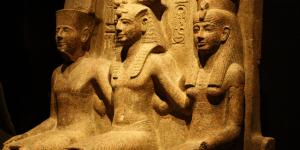You are here
Why Doctrinal Mastery?

3 Nephi 11:39
The word “doctrine” comes from the Latin word doctrina, which means “teaching.”1 The equivalent term in the Greek New Testament is didache, which comes from a root meaning, “established teaching, especially a ‘summarized’ body of respected teaching.”2 When Christ came to Book of Mormon peoples in the New World, He focused on His “doctrine” and said, “whoso buildeth upon this buildeth upon my rock, and the gates of hell shall not prevail against them” (3 Nephi 11:39).
The Book of Mormon is the doctrinal DNA of the Church, and so much of what makes these doctrines distinctive within the Restored Gospel can be found in the Book of Mormon. The word “doctrine” appears 25 times in the Book of Mormon, more times than in the Old Testament, Pearl of Great Price, or even the Doctrine and Covenants. As such, the more carefully teachers and students study the Book of Mormon, the better they will know these essential doctrines.
In an effort to follow the example set by Christ’s visit to the Nephites and help students learn the essential teachings of Christ, the Church recently introduced the Doctrinal Mastery program to be taught in Seminary and Institute and Sunday School classes everywhere.
Doctrinal Mastery shifts the focus of the old Scripture Mastery program from memorization of scriptural passages to mastery of core doctrinal teachings found throughout the scriptures.
The program focuses on 10 major doctrines:
- Acquiring spiritual knowledge
- The Godhead
- The plan of salvation
- The Atonement of Jesus Christ
- The Restoration
- Prophets and revelation
- Priesthood and priesthood keys
- Ordinances and covenants
- Marriage and family
- Commandments3
A carefully selected list of 100 scriptures—25 from each Standard Work—is used to teach these important doctrines.4 Each school year, the Seminary program focuses on one of the Standard Works and teachers incorporate lessons on these doctrinal topics and key scriptures into the year’s curriculum.
In the 2017–2018 school year, Seminary teachers and students will turn their attention again to the Book of Mormon. During the 2017 year, Book of Mormon Central will be providing resources that can be used to supplement the Doctrinal Mastry program. These resources will be aimed at several audiences, including seminary and institute teachers, and students and young single adults, and anyone who wants to learn more about how the Book of Mormon teaches these key doctrines. We hope that all people will enjoy these scriptural resources, drawing attention to insights and details that they may have overlooked before.
So, in the coming year, watch for essays that focus on Doctrinal Mastery subjects. These essays, similar to the traditional essays in our KnoWhy series, will be published with a Doctrinal Mastery focus. All of these essays will be accompanied by videos and podcasts, which hopefully teachers and students can utilize in class and at home through learning, applying, and appreciating these key gospel truths.
Topical Essays
Some essays will focus on a particular aspect of one of the 10 doctrinal topics and will explore what the Book of Mormon teaches about that topic, focusing on the doctrinal principles and how to apply them. Like the regular KnoWhy series, these will be split into two parts, but for these the parts will be “Principle” and “Application.” We hope these will help teachers and students discover new ways the Book of Mormon teaches these important doctrines and find fresh applications for its principles.
Scripture Essays
Other essays will focus on one of the 25 Book of Mormon Doctrinal Mastery scriptures. The primary focus throughout each of these essays will be how each scriptural passage teaches a principle from one of the 10 doctrinal mastery topics. To do this, the two parts to each of these essays will be “Context and Content” and then “Doctrines and Principles.”
In the Gospel Teaching and Learning handbook, it states: “Understanding the context and content of the scriptures and the words of the prophets prepares teachers and students to recognize the messages of the inspired authors.”5 To facilitate greater understanding of the context and content of these scriptural passages, the first section in these essays will briefly provide: (1) details about historical, cultural, geographic, narrative, and situational context;6 (2) literary and sometimes word analysis of the content. The focus will be on details that help draw out or emphasize the doctrines and principles taught in the passage.
The second section will use the context and content from the previous section to help identify and shed light on the key doctrines and principles taught in the passage. This section will also include additional insights on these passages from modern prophets and apostles to supplement the context and content analysis already provided. All of this will aim to create a resource that can be used in identifying, understanding, and applying the doctrines and principles taught by these key passages of scripture.
Over the course of the year, we hope these resources will aid teachers and students everywhere to better understand the doctrines taught in the Book of Mormon, helping all who do so to build “upon [His] rock” so that the “the gates of hell shall not prevail against them” (3 Nephi 11:39).
- 1. See “doctrine,” and “doctrina,” at Wiktionary: The Free Online Dictionary, online at Wiktionary.org. On the Sermon on the Mount as containing much of the authoritative doctrine or didache of Jesus, see Matthew 7:28-29, and John W. Welch, Illuminating the Sermon on the Mount and the Sermon at the Temple (Provo: FARMS, 1999), 11-12.
- 2. See Strong’s Concordance, g1322 (didaché), online at biblehub.com
- 3. See Doctrinal Mastery Core Document (Salt Lake City, UT: The Church of Jesus Christ of Latter-day Saints, 2016), online at lds.org.
- 4. Doctrinal Mastery Core Document, 12.
- 5. Gospel Teaching and Learning: A Handbook for Teachers and Leaders in Seminaries and Institutes of Religions (Salt Lake City, UT: The Church of Jesus Christ of Latter-day Saints, 2012), 23.
- 6. Gospel Teaching and Learning, 24 discusses each of these types of context, though it does not label “situational” and “narrative” context as such. Instead, situational context is called, “The question or situation that prompted the parable, event, doctrine, or principle,” and narrative is called “Who is speaking to whom and why.”
KnoWhy Citation
Related KnoWhys
Subscribe
Get the latest updates on Book of Mormon topics and research for free





